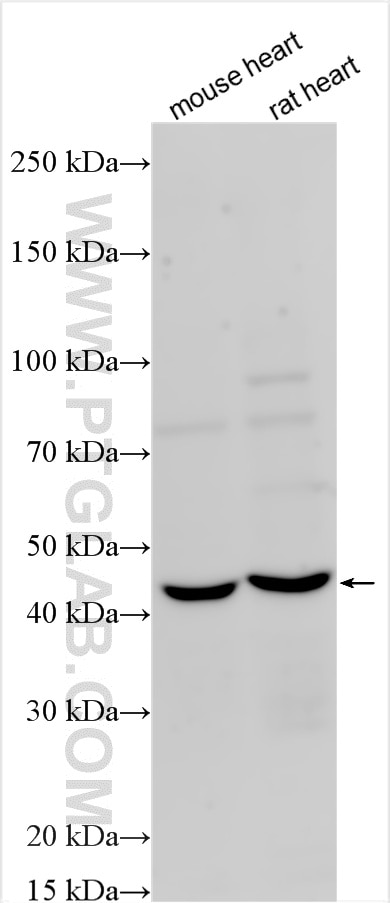Validation Data Gallery
Tested Applications
| Positive WB detected in | mouse heart tissue, rat heart tissue |
Recommended dilution
| Application | Dilution |
|---|---|
| Western Blot (WB) | WB : 1:500-1:1000 |
| It is recommended that this reagent should be titrated in each testing system to obtain optimal results. | |
| Sample-dependent, Check data in validation data gallery. | |
Product Information
33184-1-AP targets FCRL1 in WB, ELISA applications and shows reactivity with human, mouse, rat samples.
| Tested Reactivity | human, mouse, rat |
| Host / Isotype | Rabbit / IgG |
| Class | Polyclonal |
| Type | Antibody |
| Immunogen | FCRL1 fusion protein Eg3713 相同性解析による交差性が予測される生物種 |
| Full Name | Fc receptor-like 1 |
| Calculated molecular weight | 429 aa, 47 kDa |
| Observed molecular weight | 47 kDa |
| GenBank accession number | BC033690 |
| Gene Symbol | FCRL1 |
| Gene ID (NCBI) | 115350 |
| Conjugate | Unconjugated |
| Form | Liquid |
| Purification Method | Antigen affinity Purification |
| UNIPROT ID | Q96LA6 |
| Storage Buffer | PBS with 0.02% sodium azide and 50% glycerol{{ptg:BufferTemp}}7.3 |
| Storage Conditions | Store at -20°C. Stable for one year after shipment. Aliquoting is unnecessary for -20oC storage. |
Background Information
Fc receptor-like protein 1 (FCRL1) is a type I transmembrane glycoprotein that plays a crucial role in regulating B-cell receptor (BCR)-mediated signaling responses (PMID:15479727). It contains intracellular tyrosine-based motifs that can modulate BCR signaling, leading to changes in calcium flux, proliferation, and antibody production (PMID: 37822931). FCRL1 is involved in regulating B-cell development and activation, with its signaling pathways influencing ERK activation through interactions with proteins such as GRB2. This regulation is essential for maintaining B-cell homeostasis and preventing the development of autoreactive B cells (PMID: 34697226).
Protocols
| Product Specific Protocols | |
|---|---|
| WB protocol for FCRL1 antibody 33184-1-AP | Download protocol |
| Standard Protocols | |
|---|---|
| Click here to view our Standard Protocols |
